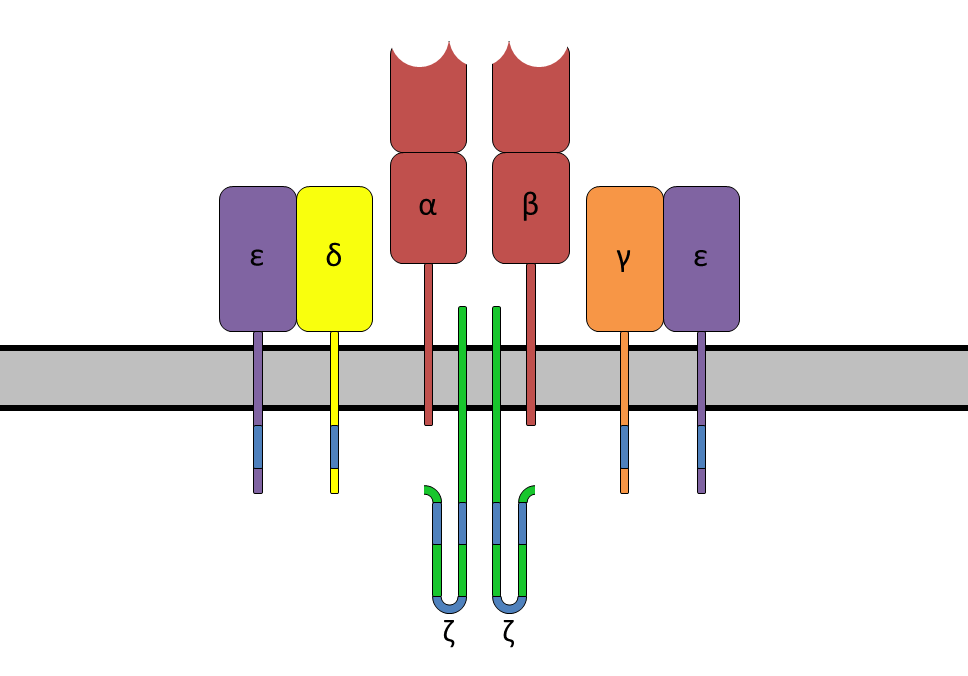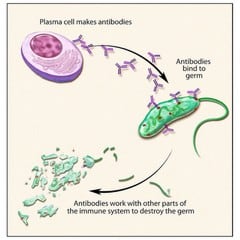T cell activation: It is initiated by recognition of a foreign peptide presented by MHC and co-stimulation signal by antigen presenting cell (APC). Dendritic cells are the most potent activators of T cells. Adhesion molecules like selectins, integrins, molecules from immunoglobulin superfamily, mucin-like molecules and chemokines aid in homing and transmigration of T cells to lymph nodes where they can interact with APCs. Initially, T cells bind with low affinity to APC through LFA 1 and ICAM 1 interactions. If the TCR (T cell receptor) recognizes the specific peptide antigen carried by corresponding MHC, then there is a conformational change in LFA 1 that increases its affinity for ICAM 1 and 2, and prolongs the duration of contact. Till now, the adhesion molecules are bound to each other, the TCR is bound to antigen and the CD4 or CD8 co-receptors are bound to MHC II and MHC I respectively. This is followed by a “co-stimulatory” signal, which is provided by the interaction of CD 28 on the T cell surface with B7 on the APC. Co-stimulation leads to clonal expansion of naive T cells to effector T cells. Activated T cells express CD40 ligand that binds to CD40 on APCs, which stimulates the expression of B7 on APC. This way, both the T cell and APC reciprocally activate each other. A check on T cell proliferation is kept by a negative signal induced by the binding of CTLA 4 (CD152) on T cells, with B7 (CD80 or 86) on the APC. In the absence of costimulation, peptide antigen binding to TCR fails to activate the T cell, leading to a state called anergy, due to which it becomes refractory to that antigen even if it is presented later by an APC. It is one of the mechanisms of developing tolerance to self-antigens.

Activated T cells produce IL2 and alpha chain of the IL2 receptor. When T cell is activated, signal transmission by CD 3 activates the phospholipase C pathway which releases intracellular Ca. Ca then activates calcineurin, which activates the genes for IL2 and IL 2 receptor synthesis. IL2 binds to its receptor on the T cell and induces its proliferation in an autocrine fashion. IL2 is a major factor that determines the differentiation and survival of CD4+ T helper subsets and CD4+ T regulatory cells, activation of cytotoxic effector lymphocytes and formation of memory T cells. Co-stimulatory signal (discussed above) is essential for IL2 production. Anergic T cells cannot produce IL2.
Activated T cells differentiate into effector T cells that function as CD4 or CD8 T cells. CD4 T cells also indirectly enhance the activation of CD8 T cells by increasing the expression of co-stimulatory molecules on APC. Effector T cells do not need co-stimulatory signals for their function. They express the integrin VLA 4 that allows them to bind to vascular endothelium.
An activated CD4 T cell can differentiate into either Th1 or Th2 cells.
| Th1 cells | Th2 cells |
| Induces cell mediated immunity | Induces humoral immunity |
| IL12 and Gamma interferon favor Th1 series | IL4,6 and 10 favor Th2 series |
| Activates macrophages | Activates B cells |
| Produce gamma interferon, IL2, TNF beta | Produce IL 4,5,6,9,10,13 |
| Seen in viral, fungal, intracellular bacterial infections, delayed hypersensitivity | Seen in allergies, parasitic infestations, bacterial infections |
B cell antigen receptor and coreceptors: The B cell antigen receptor is made of an antibody molecule that recognizes antigen and transmembrane regions, consisting of carboxy terminals of the heavy chains, that are involved with signal transduction. The cell surface immunoglobulin (Ig) that binds the antigen has the same specificity as the secreted antibodies by that B cell. In addition, one Ig alpha and one Ig beta chain are associated with the surface Ig. The Ig alpha and beta chains extend into the cytoplasm and associate with ITAM motifs. When antigen binds, the tyrosines in these ITAMs become phosphorylated by receptor-associated Src-family tyrosine kinases Blk, Fyn, or Lyn. This is followed by activation of Syk kinase which initiate a signal cascade that involves BLNK,CD19, Tec kinases (like Bruton’s tyrosine kinase) and Ras, phospholipase C (Ca++, IP3 and DAG) second messenger systems. End result is activation of transcription factors like Fos, Jun, NFAT and NFkB causing cell proliferation and differentiation. MAP kinases are activated through various pathways like ras, with a resulting signal cascade involving Raf, Mek and Erk, leading to increased transcription.

The B cell coreceptor is a complex of cell surface molecules CD19, CD 21 (or complement receptor CR 2) and CD 81. Antigen or complement C3d can cross-link the B cell receptor with the coreceptor. This results in the phosphorylation of the cytoplasmic tail of CD 19 by tyrosine kinases and signal transduction cascade involving phosphatidylinositol or PI 3 kinase. Hence, the coreceptor exponentially increases signalling.
B cell activation: Naive (unstimulated) B cells can be activated either by helper T cells or directly by microbial antigens. The first signal for activation is delivered by antigen binding to the B cell receptor. The antigen is then internalized by the B cell, processed intracellularly and then presented along with MHC II on the B cell surface. The antigen presented is then recognized by a CD4 T cell, which then delivers the second activating signal. B cell coreceptor enhances signaling by 100 to 10,000 fold. Most antigens activate B cells with T cell help and are called “T cell dependent “ antigens. Some antigens like bacterial capsular polysaccharide, DNA, RNA, lipids can activate B cells directly and are called “T cell independent” or TI antigens.

Following antigen recognition, the CD40 ligand on T cell binds to CD 40 on the B cell and secretes IL4, which stimulates and initiates proliferation of B cells. Eventually, cytokines IL5 and 6 are also secreted by the T cell which help in the differentiation of B cells into antibody secreting plasma cells. Activated B cells form germinal centers in lymphoid follicles. Cytokines induce isotype switching and that determines the predominant antibody type. IgM is the initial antibody produced.
| Cytokine | Antibody produced |
| IL4 | IgG1 and IgE |
| IL5 | IgA |
| Gamma interferon | IgG3 and IgG2 |
| TGF beta | IgG2 and IgA |
Sign up for free to take 4 quiz questions on this topic